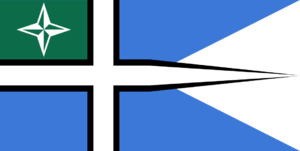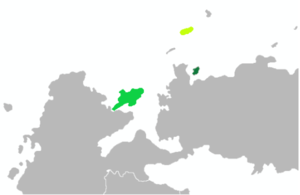Scapa: Difference between revisions
Tag: 2017 source edit |
No edit summary Tag: 2017 source edit |
||
| Line 58: | Line 58: | ||
Legal system is an idiosyncratic mix of Brehon law, feudal stuff, and Coscivian law. | Legal system is an idiosyncratic mix of Brehon law, feudal stuff, and Coscivian law. | ||
<br> | |||
<br> | |||
<br> | |||
<br> | |||
<br> | |||
==Society & Culture== | ==Society & Culture== | ||
The overwhelming majority (80-90%) of Scapallines are Gaels, most of whom have deep roots on the island and have a substantial genetic and cultural inheritance from the pre-Gaelic inhabitants of Scapa. Other Gaelic-Scapallines have more recent ancestry from Fhainnaeran, Kiravia, or Kuhlfros, though over time Gaels from overseas have quickly assimilated into the prevailing indigenous Gaelic culture. | |||
9-14% of the population of Scapa are Coscivians. Some Coscivian families have lived on the island continuously for centuries and may even be monolingual Gaelic speakers, while others are only temporary residents, such as governmental and military personnel. Most are somewhere in between. Suderavian Coscivians are the largest single Coscivian ethnic group on Scapa, owing to the close proximity of the two islands. Scapa is home to hundreds of 10th-12th generation refugees descended from the Kiravians expelled from nearby [[Wintergen]] by [[Burgundie]]. Between 200 and 500 people on Scapa are neither Gaelic nor Coscivian, but rather a heterogeneous assortment of Meridian Finns, Burgundines, non-Gaelic Kuhlfrosians, and other national minorities from Kiravia such as Tryhstians. | |||
Scapan Gaelic, a conservative dialect of Fhainnaeran [[Fhasen]] with a pronounced Impaxic substratum, is the predominant and national language of Scapa, and the Chieftaincy is actively promoting its literary and educational development to counter the influence of mainland Fhasen broadcasts and imported media. Gaelic is the primary official language, however, the register of written Gaelic used in administration is closer to [[Gaelic in Kiravia|Kiravian Gaelic]] than to the local speech, as most local officials completed their higher education at Gaelic-medium universities in the Kiravian Federacy. Suderavian Coscivian is the second-most spoken native tongue on the island, followed by Kiravic Coscivian, although Kiravic has more speakers overall, as it is the standard foreign language taught in Scapalline schools. A 21203 survey found that 32% of native-born, natively Gaelic-speaking Scapalline adults have a "reasonable" command of Kiravic or better, and an additonal 12% have "some command" of Kiravic. Several dozen islanders of Suderavian origin speak Covine as their mother tongue. | |||
Like their neighbours in Fhainnaeran, Scapans are predominantly [[Levantine Catholics]] following [whatever rite Kistan uses], though retaining some elements of the old Celtic Rite and other local traditions. There is one Catholic parish of the Coscivian Rite in Runrik. The next largest denomination is the Celtic Rite [[Insular Apostolic Church]], adhered to by much of the Coscivian population (especially Suderavian and Wintergen Coscivians), as well as some old-stock Scapans. A small Coscivian Orthodox chapel in Runrik is served on holy days of obligation by a visiting priest from Suderavia. The largest non-Christian religion on Scapa is the Bahá'í Faith, which had a period of rapid growth in Kiravia in the 21180s. The Scapa National Spiritual Assembly of Bahá'ís claims 44 enrolled members (0.19% of the population) and 19 active congregants. | |||
{{Pie chart | |||
|thumb = right | |||
|title=<center>Ethnocultural Breakdown</center> | |||
|titlebar=#ddd | |||
|caption = ''Ethnocultural Breakdown of Scapa'' | |||
|label1 = Gaels | |||
|value1 = 83.7 | |||
|color1 = #4CBB17 | |||
|label2 = [[Coscivian civilisation#People|Coscivians]] | |||
|value2 = 14.2 | |||
|color2 = #004953 | |||
|label3 = ''Other'' | |||
|value3 = 2.1 | |||
|color3 = Gainsboro | |||
}} | |||
==Economy== | ==Economy== | ||
Not much, really. Pretty much just sheep raising, handicrafts, subsistence farming, fishing, some tourism. The economy is heavily dependent on remittances from Scapallines working in Kiravia and Fhainnaeran. | Not much, really. Pretty much just sheep raising, handicrafts, subsistence farming, fishing, some tourism. The economy is heavily dependent on remittances from Scapallines working in Kiravia and Fhainnaeran. | ||
In terms of public finance, most government revenue comes from Kiravian federal aid, administrative and registration fees, and proceeds from the sale of stamps, .sp domain names, and the like. A {{wp|sovereign wealth fund}}, the Scapa Community Future Trust, was established in 21189 to contribute to the island's long-term fiscal stability. | In terms of public finance, most government revenue comes from Kiravian federal aid, administrative and registration fees, and proceeds from the sale of stamps, .sp domain names, and the like. A {{wp|sovereign wealth fund}}, the Scapa Community Future Trust, was established in 21189 to contribute to the island's long-term fiscal stability. | ||
{{wp|Peat}} is the primary energy source for households and small businesses on Scapa. The right of households to cut peat is governed by time-honoured Gaelic and feudal custom. The Peat Office, directed by the Secretary of Peat, issues guidelines for sustainable peat harvesting and consumption, oversees an initiative to install high-efficiency peat-fuelled generators, and bears responsibility for the conservation and regeneration of peat bogs. The Chieftain's 2030 Clear Horizon Initiative seeks to develop the island's wind and tidal energy capacity, in order to replace hydrocarbon fuels and reduce dependency on peat for domestic energy. | |||
[[Category:Kiravian federal subjects]] | [[Category:Kiravian federal subjects]] | ||
[[Category:IXWB]] | [[Category:IXWB]] | ||
Revision as of 01:48, 3 January 2021
| Chieftaincy of Scapa Dál Scapa | |
 Flag | |

| |
| Scapa in dark green, other Kiravian territories in medium green, disputed Kiravian territories in lime. | |
| Sovereignty | Kiravian Federacy |
| Capital | Runrik |
| Population | 22,938 |
| High Commissioner | N. Síkurin Krósseden |
| Taoiseach | Ualraig McRaven |
| Táinaiste | Ciarán MacShithich |
| Legislature | Council |
| Stanora seats | 1 (votes only in committee) |
| Official languages | Kiravian Gaelic Standard Coscivian |
| National language | Scapa Gaelic |
| Postal Abbreviation | SKP |
| Time Zone | Central Levantine Time |
Scapa is a dependent state of the Kiravian Federacy comprising an offshore island of the same name on the southeastern rim of the Kilikas Sea adjacent to northwesten Fhainnaeran.
History
Scapa has been inhabited continuously since the Neolithic Age. Its rich archæological inheritance, its culture, and the genetic makeup of its people reflect several waves of cultures and peoples taking root on the island, including the pre-Aryan Old Levantine indigenes, the Impaxi, and the Goidelic Celts.
Kiravian protectorate (15XX?-Present)
Probably some shit like the local chieftain fell out with whomst'veever the High King of Kistannaeran was and swore fealty to the Marble Emperor instead "lmao how a statue gonna tax my ass bottom text".
Governance
Pretty standard British-style protectorate arrangement. Islanders not automatically Kiravian citizens, but rather carry Kiravian passports as "Kiravian-Protected Persons", though about 40% of islanders have acquired Kiravian nationality.
Basically a clan tanistry system pressed into the mould of a semi-presidential republic, with the Chief (Taoiseach) fulfilling the role of president and the Tánaiste that of Prime Minister. The legislative body is the Council, and the constituencies are hereditary Septs + two seats reserved for Outlanders.
Legal system is an idiosyncratic mix of Brehon law, feudal stuff, and Coscivian law.
Society & Culture
The overwhelming majority (80-90%) of Scapallines are Gaels, most of whom have deep roots on the island and have a substantial genetic and cultural inheritance from the pre-Gaelic inhabitants of Scapa. Other Gaelic-Scapallines have more recent ancestry from Fhainnaeran, Kiravia, or Kuhlfros, though over time Gaels from overseas have quickly assimilated into the prevailing indigenous Gaelic culture.
9-14% of the population of Scapa are Coscivians. Some Coscivian families have lived on the island continuously for centuries and may even be monolingual Gaelic speakers, while others are only temporary residents, such as governmental and military personnel. Most are somewhere in between. Suderavian Coscivians are the largest single Coscivian ethnic group on Scapa, owing to the close proximity of the two islands. Scapa is home to hundreds of 10th-12th generation refugees descended from the Kiravians expelled from nearby Wintergen by Burgundie. Between 200 and 500 people on Scapa are neither Gaelic nor Coscivian, but rather a heterogeneous assortment of Meridian Finns, Burgundines, non-Gaelic Kuhlfrosians, and other national minorities from Kiravia such as Tryhstians.
Scapan Gaelic, a conservative dialect of Fhainnaeran Fhasen with a pronounced Impaxic substratum, is the predominant and national language of Scapa, and the Chieftaincy is actively promoting its literary and educational development to counter the influence of mainland Fhasen broadcasts and imported media. Gaelic is the primary official language, however, the register of written Gaelic used in administration is closer to Kiravian Gaelic than to the local speech, as most local officials completed their higher education at Gaelic-medium universities in the Kiravian Federacy. Suderavian Coscivian is the second-most spoken native tongue on the island, followed by Kiravic Coscivian, although Kiravic has more speakers overall, as it is the standard foreign language taught in Scapalline schools. A 21203 survey found that 32% of native-born, natively Gaelic-speaking Scapalline adults have a "reasonable" command of Kiravic or better, and an additonal 12% have "some command" of Kiravic. Several dozen islanders of Suderavian origin speak Covine as their mother tongue.
Like their neighbours in Fhainnaeran, Scapans are predominantly Levantine Catholics following [whatever rite Kistan uses], though retaining some elements of the old Celtic Rite and other local traditions. There is one Catholic parish of the Coscivian Rite in Runrik. The next largest denomination is the Celtic Rite Insular Apostolic Church, adhered to by much of the Coscivian population (especially Suderavian and Wintergen Coscivians), as well as some old-stock Scapans. A small Coscivian Orthodox chapel in Runrik is served on holy days of obligation by a visiting priest from Suderavia. The largest non-Christian religion on Scapa is the Bahá'í Faith, which had a period of rapid growth in Kiravia in the 21180s. The Scapa National Spiritual Assembly of Bahá'ís claims 44 enrolled members (0.19% of the population) and 19 active congregants.
Economy
Not much, really. Pretty much just sheep raising, handicrafts, subsistence farming, fishing, some tourism. The economy is heavily dependent on remittances from Scapallines working in Kiravia and Fhainnaeran.
In terms of public finance, most government revenue comes from Kiravian federal aid, administrative and registration fees, and proceeds from the sale of stamps, .sp domain names, and the like. A sovereign wealth fund, the Scapa Community Future Trust, was established in 21189 to contribute to the island's long-term fiscal stability.
Peat is the primary energy source for households and small businesses on Scapa. The right of households to cut peat is governed by time-honoured Gaelic and feudal custom. The Peat Office, directed by the Secretary of Peat, issues guidelines for sustainable peat harvesting and consumption, oversees an initiative to install high-efficiency peat-fuelled generators, and bears responsibility for the conservation and regeneration of peat bogs. The Chieftain's 2030 Clear Horizon Initiative seeks to develop the island's wind and tidal energy capacity, in order to replace hydrocarbon fuels and reduce dependency on peat for domestic energy.